AV Roe PLC: Management Accounting Issues and Investment Appraisal
VerifiedAdded on 2023/01/12
|22
|3695
|29
Report
AI Summary
This report provides a detailed analysis of management accounting issues at AV Roe PLC, a company transitioning into medical equipment production. The report addresses three key issues: capital investment appraisal for ventilator options, surgical mask costing analysis, and a respiratory Davison budget. The analysis includes calculations for payback period, net present value, accounting rate of return, and internal rate of return to evaluate ventilator investment alternatives. Furthermore, it assesses surgical mask costing through break-even point and margin of safety calculations for different pricing options. The report concludes with recommendations for AV Roe's management based on the financial analysis, discussing the limitations of the methods used.

Accounting for Business
Paraphrase This Document
Need a fresh take? Get an instant paraphrase of this document with our AI Paraphraser
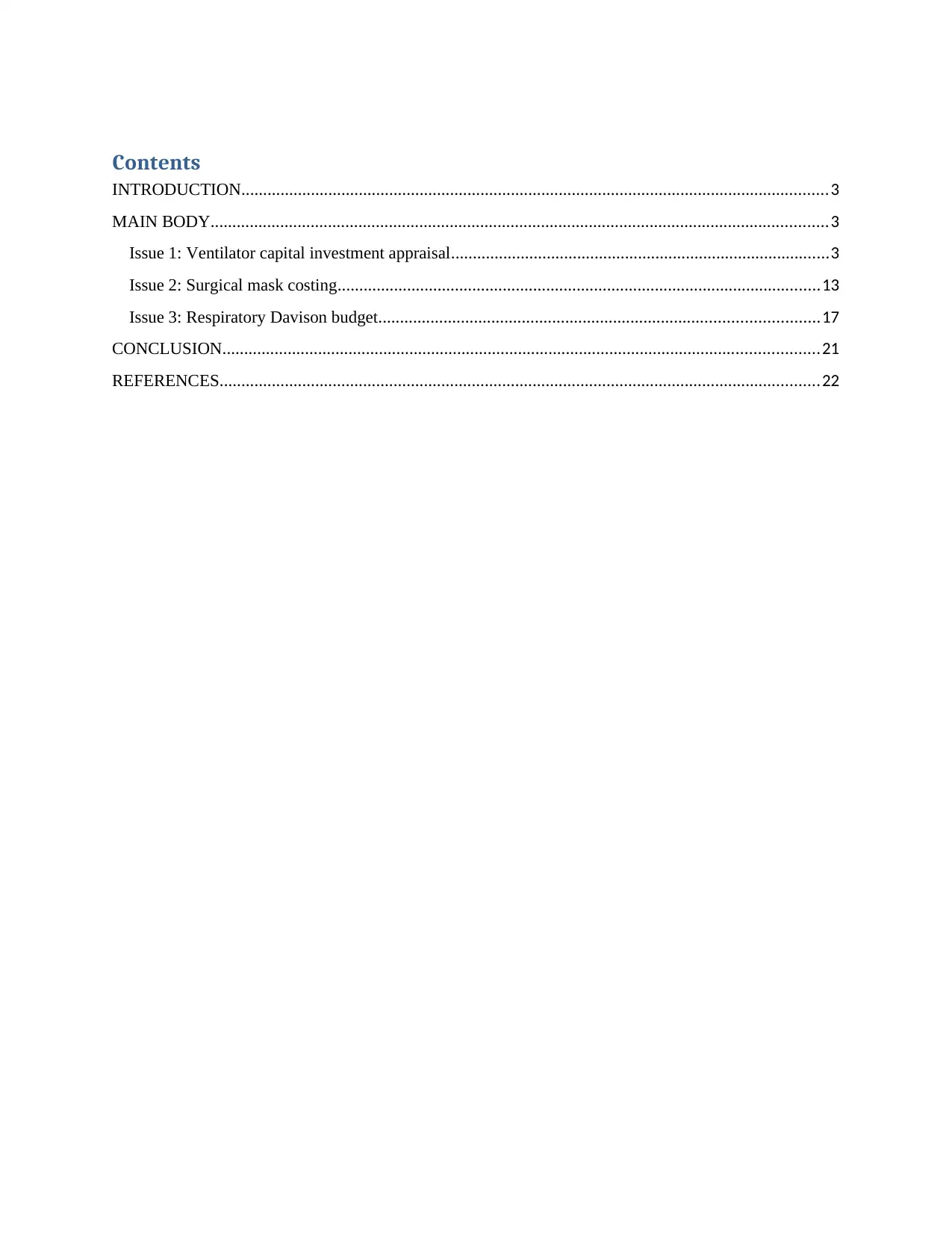
Contents
INTRODUCTION.......................................................................................................................................3
MAIN BODY..............................................................................................................................................3
Issue 1: Ventilator capital investment appraisal.......................................................................................3
Issue 2: Surgical mask costing...............................................................................................................13
Issue 3: Respiratory Davison budget.....................................................................................................17
CONCLUSION.........................................................................................................................................21
REFERENCES..........................................................................................................................................22
INTRODUCTION.......................................................................................................................................3
MAIN BODY..............................................................................................................................................3
Issue 1: Ventilator capital investment appraisal.......................................................................................3
Issue 2: Surgical mask costing...............................................................................................................13
Issue 3: Respiratory Davison budget.....................................................................................................17
CONCLUSION.........................................................................................................................................21
REFERENCES..........................................................................................................................................22
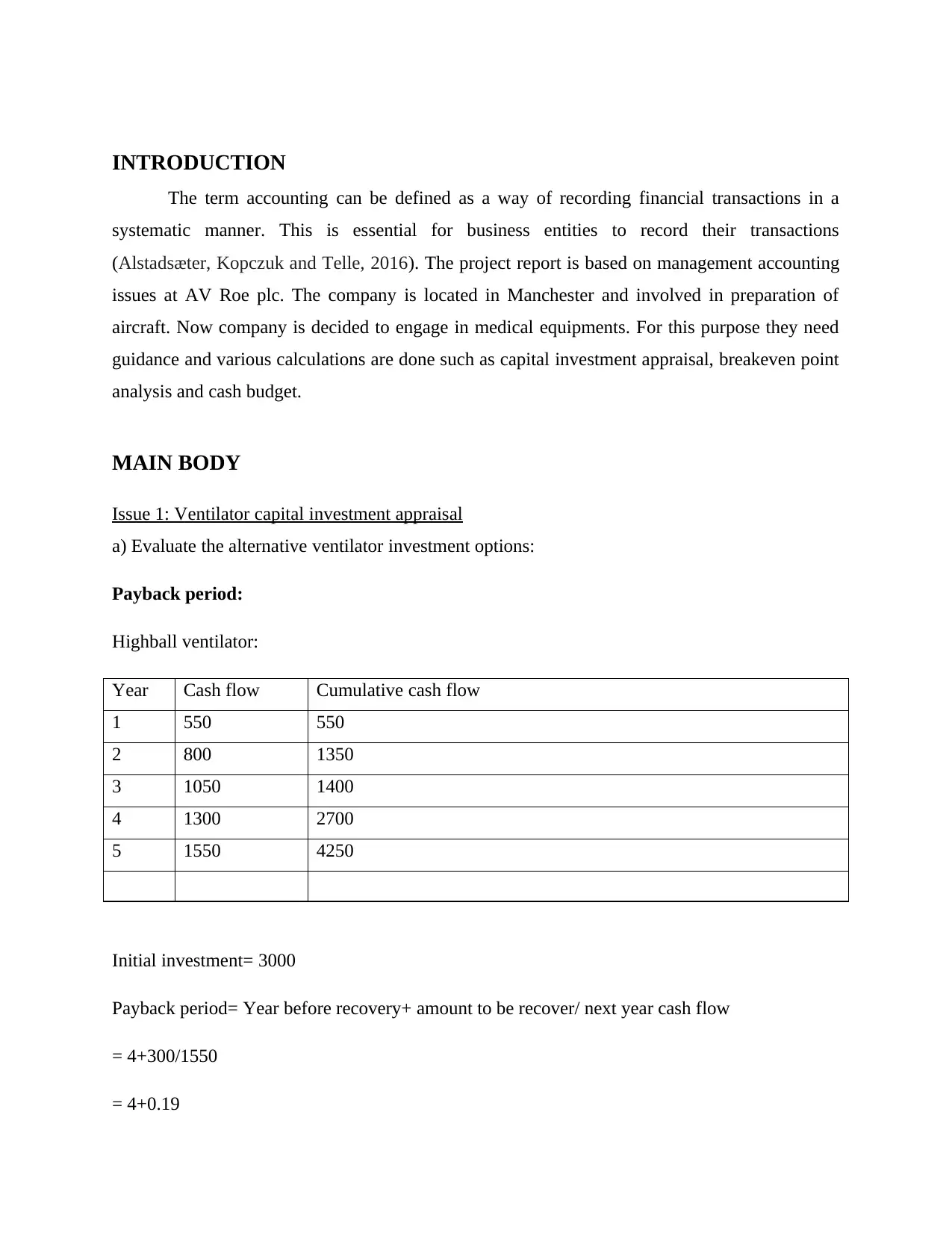
INTRODUCTION
The term accounting can be defined as a way of recording financial transactions in a
systematic manner. This is essential for business entities to record their transactions
(Alstadsæter, Kopczuk and Telle, 2016). The project report is based on management accounting
issues at AV Roe plc. The company is located in Manchester and involved in preparation of
aircraft. Now company is decided to engage in medical equipments. For this purpose they need
guidance and various calculations are done such as capital investment appraisal, breakeven point
analysis and cash budget.
MAIN BODY
Issue 1: Ventilator capital investment appraisal
a) Evaluate the alternative ventilator investment options:
Payback period:
Highball ventilator:
Year Cash flow Cumulative cash flow
1 550 550
2 800 1350
3 1050 1400
4 1300 2700
5 1550 4250
Initial investment= 3000
Payback period= Year before recovery+ amount to be recover/ next year cash flow
= 4+300/1550
= 4+0.19
The term accounting can be defined as a way of recording financial transactions in a
systematic manner. This is essential for business entities to record their transactions
(Alstadsæter, Kopczuk and Telle, 2016). The project report is based on management accounting
issues at AV Roe plc. The company is located in Manchester and involved in preparation of
aircraft. Now company is decided to engage in medical equipments. For this purpose they need
guidance and various calculations are done such as capital investment appraisal, breakeven point
analysis and cash budget.
MAIN BODY
Issue 1: Ventilator capital investment appraisal
a) Evaluate the alternative ventilator investment options:
Payback period:
Highball ventilator:
Year Cash flow Cumulative cash flow
1 550 550
2 800 1350
3 1050 1400
4 1300 2700
5 1550 4250
Initial investment= 3000
Payback period= Year before recovery+ amount to be recover/ next year cash flow
= 4+300/1550
= 4+0.19
⊘ This is a preview!⊘
Do you want full access?
Subscribe today to unlock all pages.

Trusted by 1+ million students worldwide
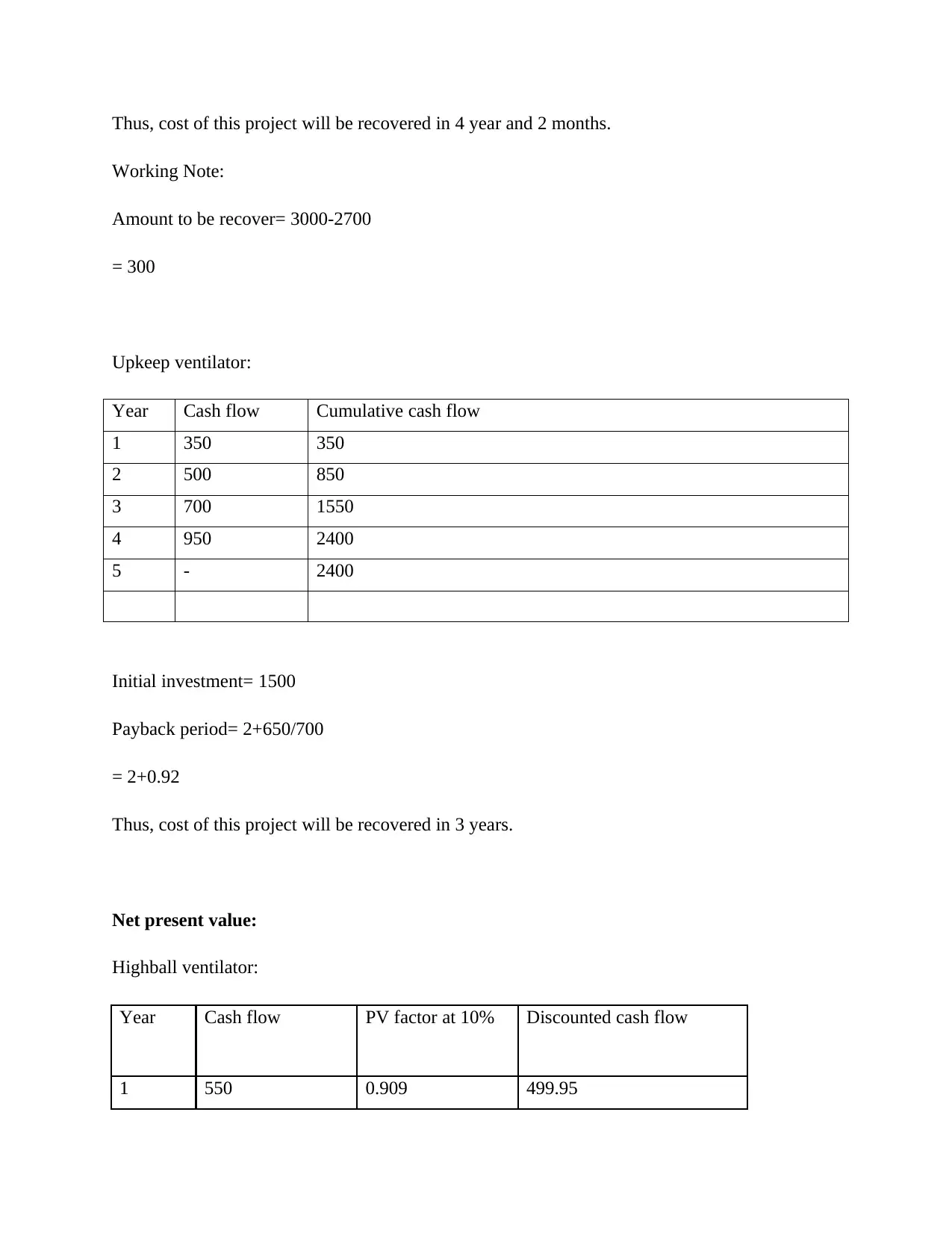
Thus, cost of this project will be recovered in 4 year and 2 months.
Working Note:
Amount to be recover= 3000-2700
= 300
Upkeep ventilator:
Year Cash flow Cumulative cash flow
1 350 350
2 500 850
3 700 1550
4 950 2400
5 - 2400
Initial investment= 1500
Payback period= 2+650/700
= 2+0.92
Thus, cost of this project will be recovered in 3 years.
Net present value:
Highball ventilator:
Year Cash flow PV factor at 10% Discounted cash flow
1 550 0.909 499.95
Working Note:
Amount to be recover= 3000-2700
= 300
Upkeep ventilator:
Year Cash flow Cumulative cash flow
1 350 350
2 500 850
3 700 1550
4 950 2400
5 - 2400
Initial investment= 1500
Payback period= 2+650/700
= 2+0.92
Thus, cost of this project will be recovered in 3 years.
Net present value:
Highball ventilator:
Year Cash flow PV factor at 10% Discounted cash flow
1 550 0.909 499.95
Paraphrase This Document
Need a fresh take? Get an instant paraphrase of this document with our AI Paraphraser
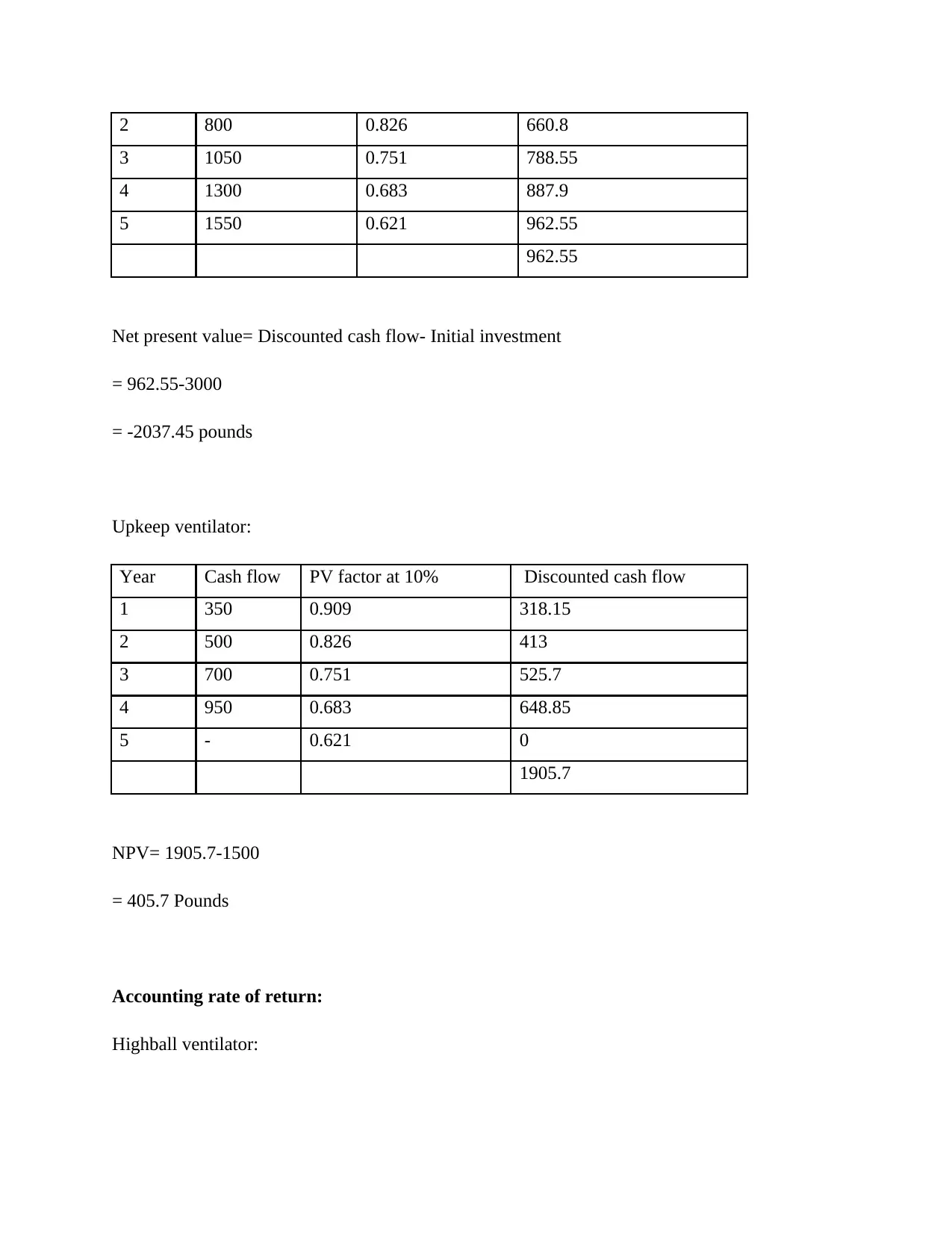
2 800 0.826 660.8
3 1050 0.751 788.55
4 1300 0.683 887.9
5 1550 0.621 962.55
962.55
Net present value= Discounted cash flow- Initial investment
= 962.55-3000
= -2037.45 pounds
Upkeep ventilator:
Year Cash flow PV factor at 10% Discounted cash flow
1 350 0.909 318.15
2 500 0.826 413
3 700 0.751 525.7
4 950 0.683 648.85
5 - 0.621 0
1905.7
NPV= 1905.7-1500
= 405.7 Pounds
Accounting rate of return:
Highball ventilator:
3 1050 0.751 788.55
4 1300 0.683 887.9
5 1550 0.621 962.55
962.55
Net present value= Discounted cash flow- Initial investment
= 962.55-3000
= -2037.45 pounds
Upkeep ventilator:
Year Cash flow PV factor at 10% Discounted cash flow
1 350 0.909 318.15
2 500 0.826 413
3 700 0.751 525.7
4 950 0.683 648.85
5 - 0.621 0
1905.7
NPV= 1905.7-1500
= 405.7 Pounds
Accounting rate of return:
Highball ventilator:
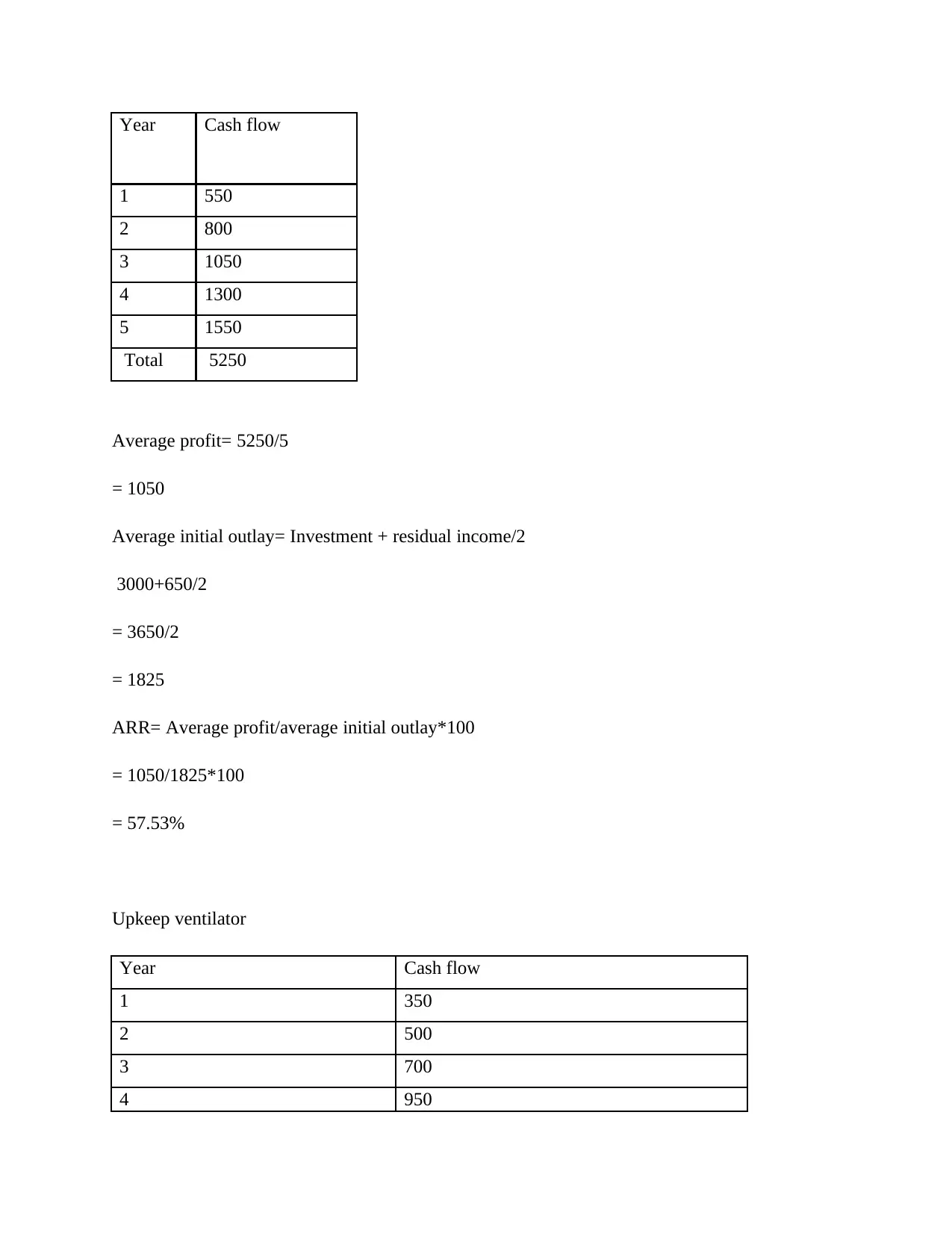
Year Cash flow
1 550
2 800
3 1050
4 1300
5 1550
Total 5250
Average profit= 5250/5
= 1050
Average initial outlay= Investment + residual income/2
3000+650/2
= 3650/2
= 1825
ARR= Average profit/average initial outlay*100
= 1050/1825*100
= 57.53%
Upkeep ventilator
Year Cash flow
1 350
2 500
3 700
4 950
1 550
2 800
3 1050
4 1300
5 1550
Total 5250
Average profit= 5250/5
= 1050
Average initial outlay= Investment + residual income/2
3000+650/2
= 3650/2
= 1825
ARR= Average profit/average initial outlay*100
= 1050/1825*100
= 57.53%
Upkeep ventilator
Year Cash flow
1 350
2 500
3 700
4 950
⊘ This is a preview!⊘
Do you want full access?
Subscribe today to unlock all pages.

Trusted by 1+ million students worldwide
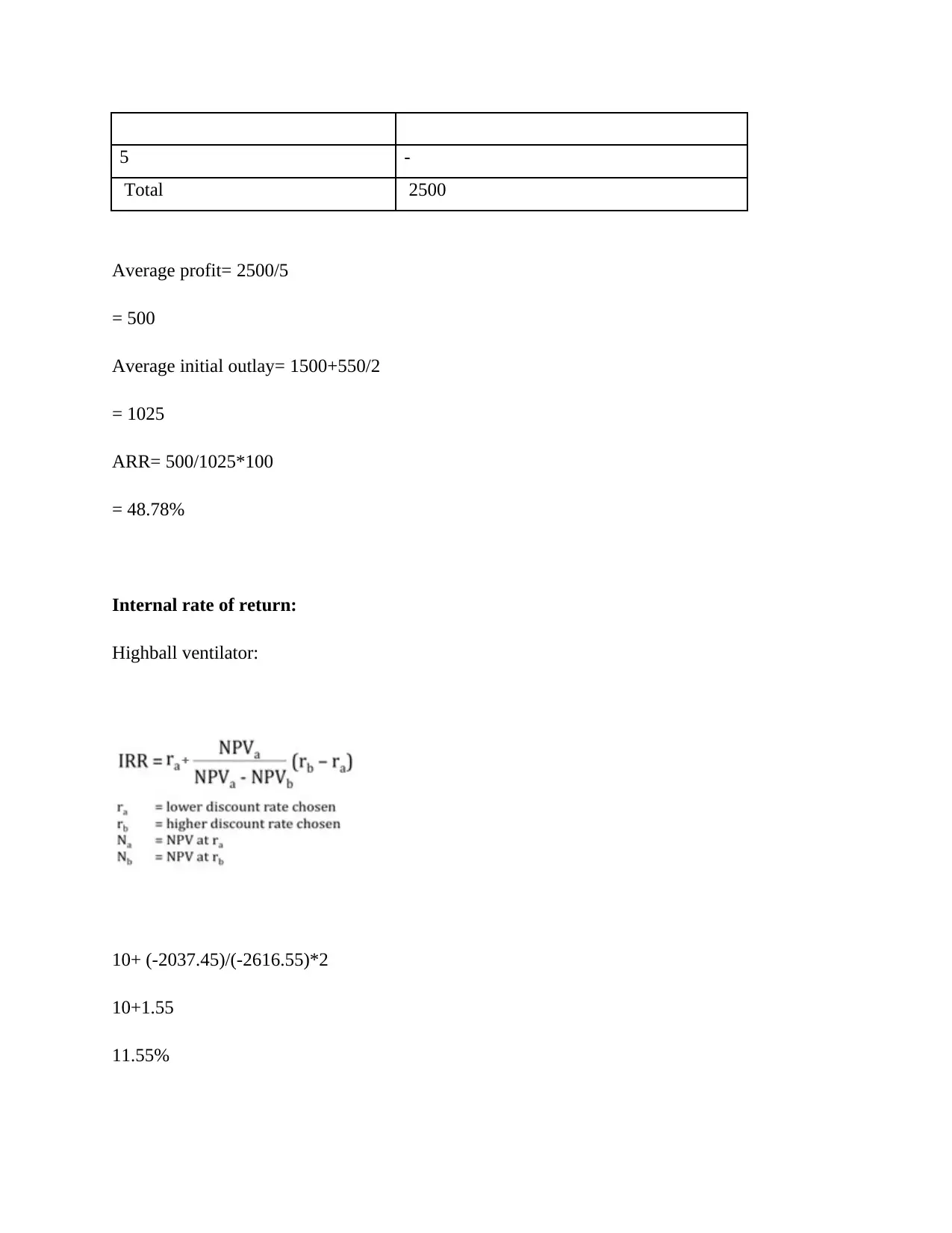
5 -
Total 2500
Average profit= 2500/5
= 500
Average initial outlay= 1500+550/2
= 1025
ARR= 500/1025*100
= 48.78%
Internal rate of return:
Highball ventilator:
10+ (-2037.45)/(-2616.55)*2
10+1.55
11.55%
Total 2500
Average profit= 2500/5
= 500
Average initial outlay= 1500+550/2
= 1025
ARR= 500/1025*100
= 48.78%
Internal rate of return:
Highball ventilator:
10+ (-2037.45)/(-2616.55)*2
10+1.55
11.55%
Paraphrase This Document
Need a fresh take? Get an instant paraphrase of this document with our AI Paraphraser
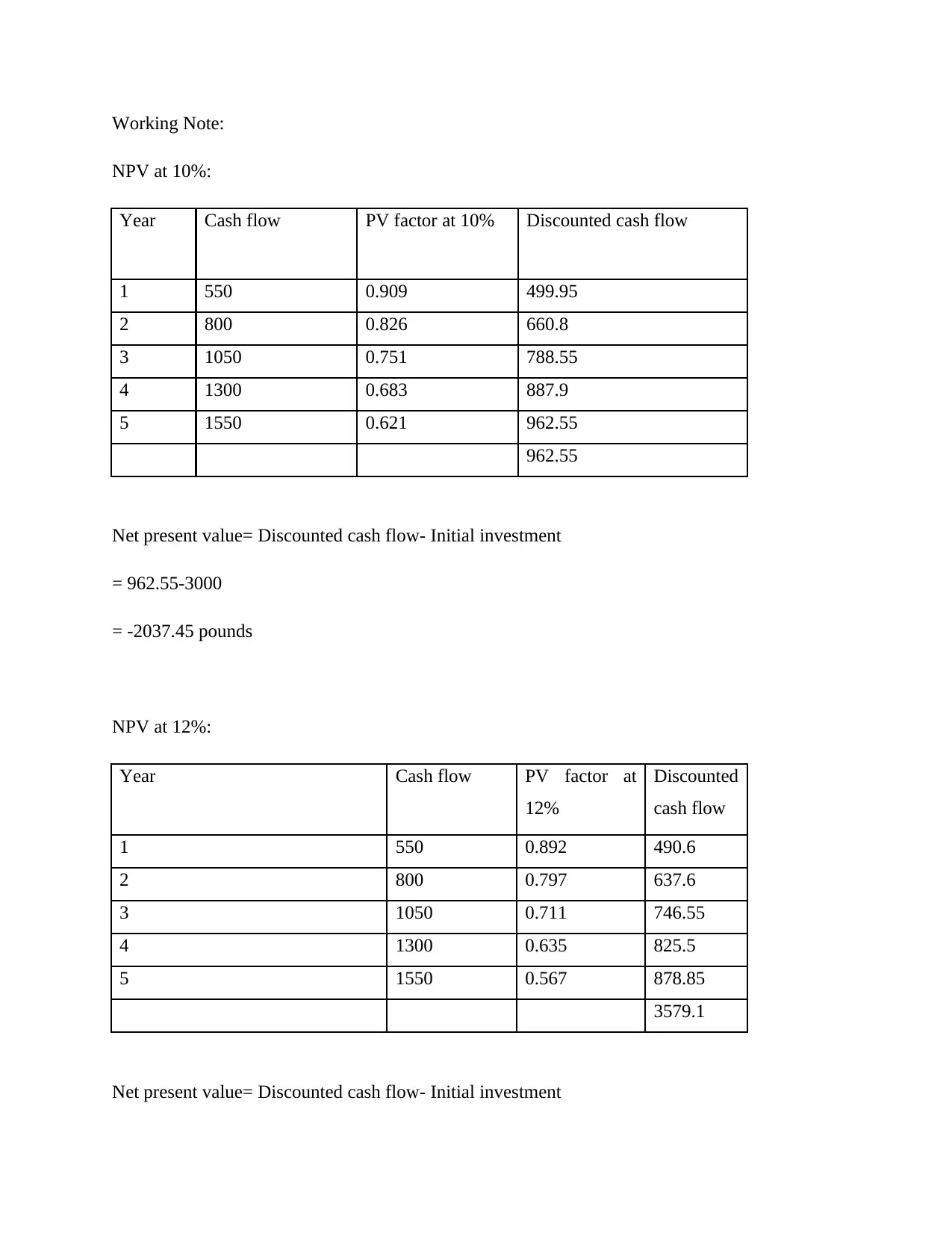
Working Note:
NPV at 10%:
Year Cash flow PV factor at 10% Discounted cash flow
1 550 0.909 499.95
2 800 0.826 660.8
3 1050 0.751 788.55
4 1300 0.683 887.9
5 1550 0.621 962.55
962.55
Net present value= Discounted cash flow- Initial investment
= 962.55-3000
= -2037.45 pounds
NPV at 12%:
Year Cash flow PV factor at
12%
Discounted
cash flow
1 550 0.892 490.6
2 800 0.797 637.6
3 1050 0.711 746.55
4 1300 0.635 825.5
5 1550 0.567 878.85
3579.1
Net present value= Discounted cash flow- Initial investment
NPV at 10%:
Year Cash flow PV factor at 10% Discounted cash flow
1 550 0.909 499.95
2 800 0.826 660.8
3 1050 0.751 788.55
4 1300 0.683 887.9
5 1550 0.621 962.55
962.55
Net present value= Discounted cash flow- Initial investment
= 962.55-3000
= -2037.45 pounds
NPV at 12%:
Year Cash flow PV factor at
12%
Discounted
cash flow
1 550 0.892 490.6
2 800 0.797 637.6
3 1050 0.711 746.55
4 1300 0.635 825.5
5 1550 0.567 878.85
3579.1
Net present value= Discounted cash flow- Initial investment
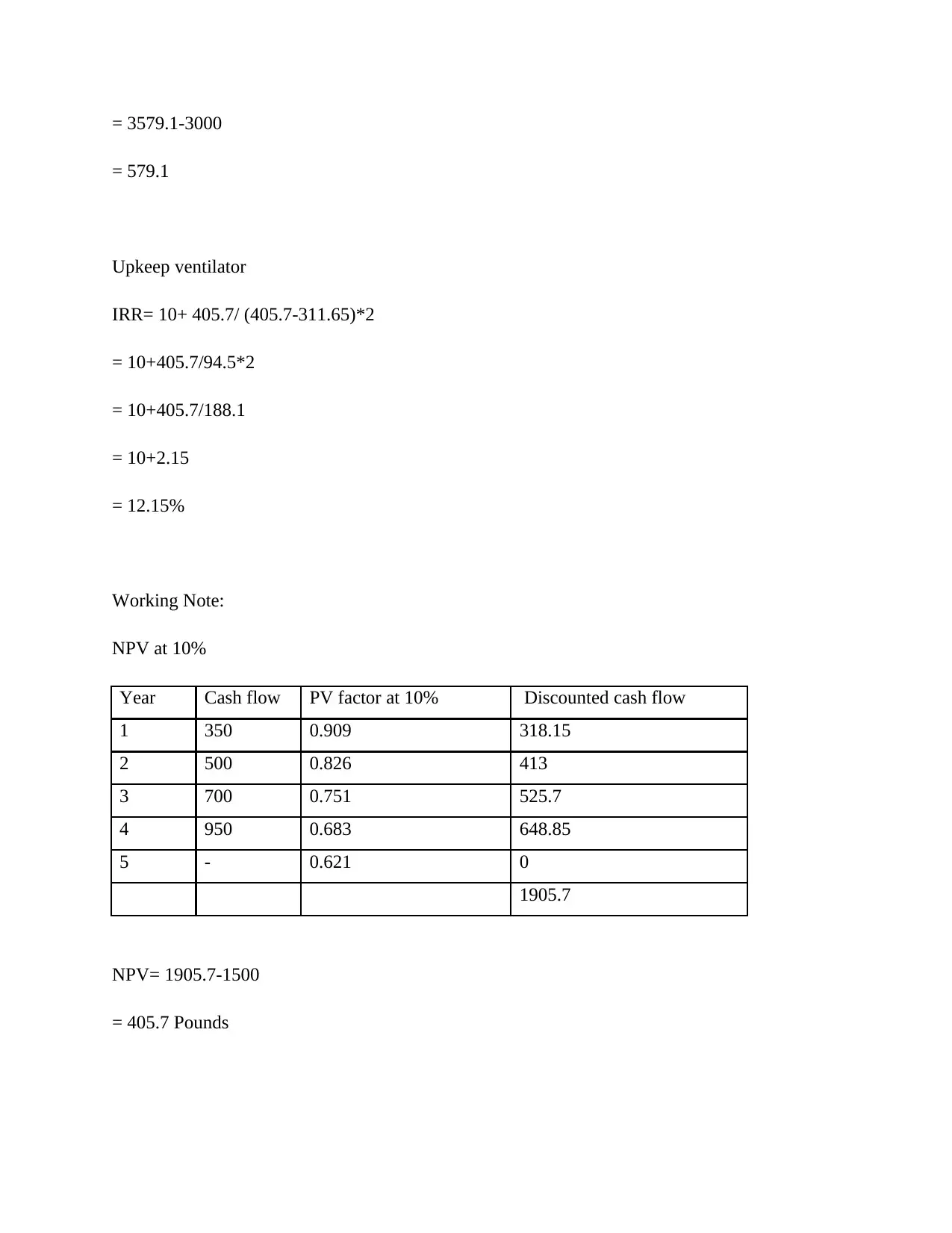
= 3579.1-3000
= 579.1
Upkeep ventilator
IRR= 10+ 405.7/ (405.7-311.65)*2
= 10+405.7/94.5*2
= 10+405.7/188.1
= 10+2.15
= 12.15%
Working Note:
NPV at 10%
Year Cash flow PV factor at 10% Discounted cash flow
1 350 0.909 318.15
2 500 0.826 413
3 700 0.751 525.7
4 950 0.683 648.85
5 - 0.621 0
1905.7
NPV= 1905.7-1500
= 405.7 Pounds
= 579.1
Upkeep ventilator
IRR= 10+ 405.7/ (405.7-311.65)*2
= 10+405.7/94.5*2
= 10+405.7/188.1
= 10+2.15
= 12.15%
Working Note:
NPV at 10%
Year Cash flow PV factor at 10% Discounted cash flow
1 350 0.909 318.15
2 500 0.826 413
3 700 0.751 525.7
4 950 0.683 648.85
5 - 0.621 0
1905.7
NPV= 1905.7-1500
= 405.7 Pounds
⊘ This is a preview!⊘
Do you want full access?
Subscribe today to unlock all pages.

Trusted by 1+ million students worldwide
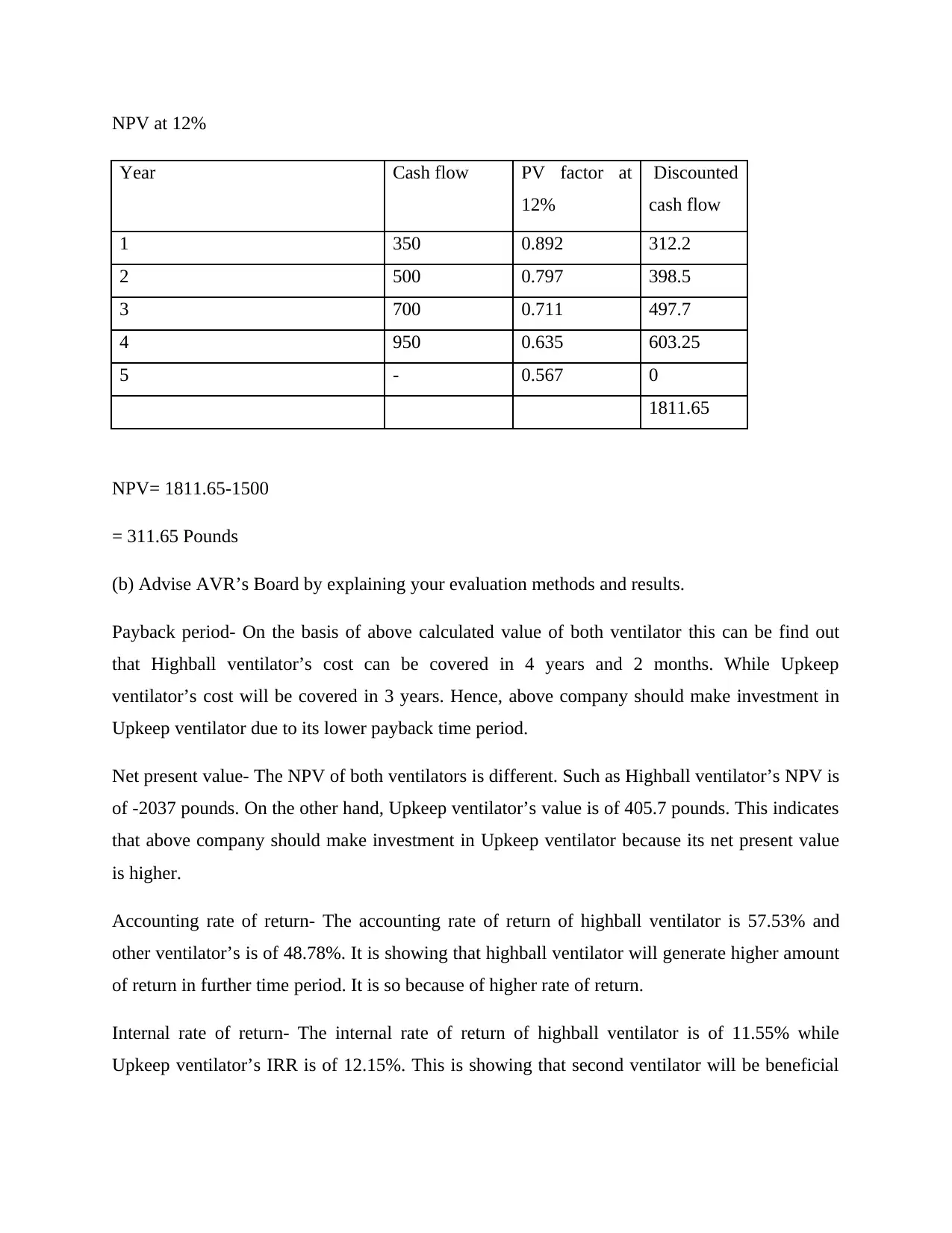
NPV at 12%
Year Cash flow PV factor at
12%
Discounted
cash flow
1 350 0.892 312.2
2 500 0.797 398.5
3 700 0.711 497.7
4 950 0.635 603.25
5 - 0.567 0
1811.65
NPV= 1811.65-1500
= 311.65 Pounds
(b) Advise AVR’s Board by explaining your evaluation methods and results.
Payback period- On the basis of above calculated value of both ventilator this can be find out
that Highball ventilator’s cost can be covered in 4 years and 2 months. While Upkeep
ventilator’s cost will be covered in 3 years. Hence, above company should make investment in
Upkeep ventilator due to its lower payback time period.
Net present value- The NPV of both ventilators is different. Such as Highball ventilator’s NPV is
of -2037 pounds. On the other hand, Upkeep ventilator’s value is of 405.7 pounds. This indicates
that above company should make investment in Upkeep ventilator because its net present value
is higher.
Accounting rate of return- The accounting rate of return of highball ventilator is 57.53% and
other ventilator’s is of 48.78%. It is showing that highball ventilator will generate higher amount
of return in further time period. It is so because of higher rate of return.
Internal rate of return- The internal rate of return of highball ventilator is of 11.55% while
Upkeep ventilator’s IRR is of 12.15%. This is showing that second ventilator will be beneficial
Year Cash flow PV factor at
12%
Discounted
cash flow
1 350 0.892 312.2
2 500 0.797 398.5
3 700 0.711 497.7
4 950 0.635 603.25
5 - 0.567 0
1811.65
NPV= 1811.65-1500
= 311.65 Pounds
(b) Advise AVR’s Board by explaining your evaluation methods and results.
Payback period- On the basis of above calculated value of both ventilator this can be find out
that Highball ventilator’s cost can be covered in 4 years and 2 months. While Upkeep
ventilator’s cost will be covered in 3 years. Hence, above company should make investment in
Upkeep ventilator due to its lower payback time period.
Net present value- The NPV of both ventilators is different. Such as Highball ventilator’s NPV is
of -2037 pounds. On the other hand, Upkeep ventilator’s value is of 405.7 pounds. This indicates
that above company should make investment in Upkeep ventilator because its net present value
is higher.
Accounting rate of return- The accounting rate of return of highball ventilator is 57.53% and
other ventilator’s is of 48.78%. It is showing that highball ventilator will generate higher amount
of return in further time period. It is so because of higher rate of return.
Internal rate of return- The internal rate of return of highball ventilator is of 11.55% while
Upkeep ventilator’s IRR is of 12.15%. This is showing that second ventilator will be beneficial
Paraphrase This Document
Need a fresh take? Get an instant paraphrase of this document with our AI Paraphraser
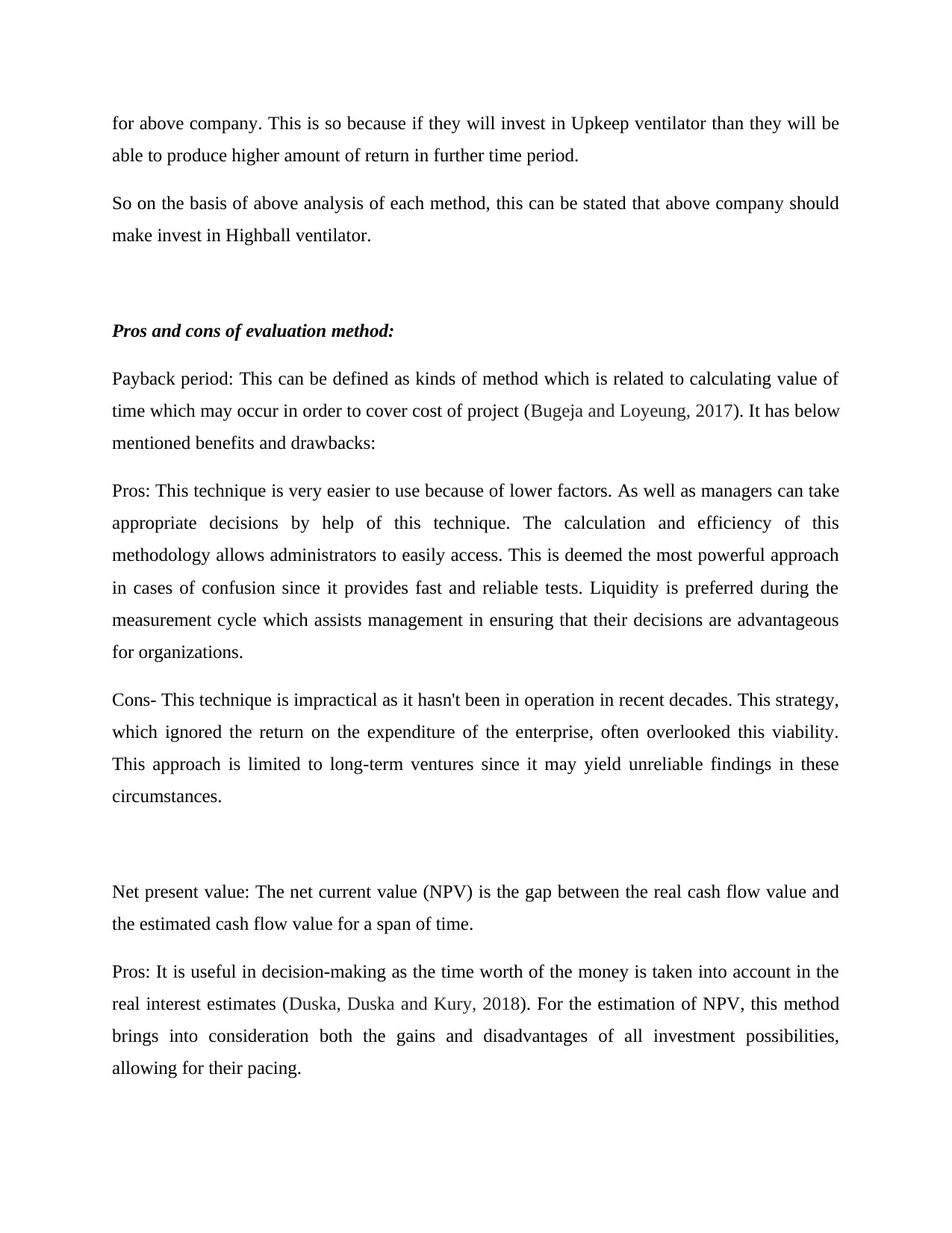
for above company. This is so because if they will invest in Upkeep ventilator than they will be
able to produce higher amount of return in further time period.
So on the basis of above analysis of each method, this can be stated that above company should
make invest in Highball ventilator.
Pros and cons of evaluation method:
Payback period: This can be defined as kinds of method which is related to calculating value of
time which may occur in order to cover cost of project (Bugeja and Loyeung, 2017). It has below
mentioned benefits and drawbacks:
Pros: This technique is very easier to use because of lower factors. As well as managers can take
appropriate decisions by help of this technique. The calculation and efficiency of this
methodology allows administrators to easily access. This is deemed the most powerful approach
in cases of confusion since it provides fast and reliable tests. Liquidity is preferred during the
measurement cycle which assists management in ensuring that their decisions are advantageous
for organizations.
Cons- This technique is impractical as it hasn't been in operation in recent decades. This strategy,
which ignored the return on the expenditure of the enterprise, often overlooked this viability.
This approach is limited to long-term ventures since it may yield unreliable findings in these
circumstances.
Net present value: The net current value (NPV) is the gap between the real cash flow value and
the estimated cash flow value for a span of time.
Pros: It is useful in decision-making as the time worth of the money is taken into account in the
real interest estimates (Duska, Duska and Kury, 2018). For the estimation of NPV, this method
brings into consideration both the gains and disadvantages of all investment possibilities,
allowing for their pacing.
able to produce higher amount of return in further time period.
So on the basis of above analysis of each method, this can be stated that above company should
make invest in Highball ventilator.
Pros and cons of evaluation method:
Payback period: This can be defined as kinds of method which is related to calculating value of
time which may occur in order to cover cost of project (Bugeja and Loyeung, 2017). It has below
mentioned benefits and drawbacks:
Pros: This technique is very easier to use because of lower factors. As well as managers can take
appropriate decisions by help of this technique. The calculation and efficiency of this
methodology allows administrators to easily access. This is deemed the most powerful approach
in cases of confusion since it provides fast and reliable tests. Liquidity is preferred during the
measurement cycle which assists management in ensuring that their decisions are advantageous
for organizations.
Cons- This technique is impractical as it hasn't been in operation in recent decades. This strategy,
which ignored the return on the expenditure of the enterprise, often overlooked this viability.
This approach is limited to long-term ventures since it may yield unreliable findings in these
circumstances.
Net present value: The net current value (NPV) is the gap between the real cash flow value and
the estimated cash flow value for a span of time.
Pros: It is useful in decision-making as the time worth of the money is taken into account in the
real interest estimates (Duska, Duska and Kury, 2018). For the estimation of NPV, this method
brings into consideration both the gains and disadvantages of all investment possibilities,
allowing for their pacing.
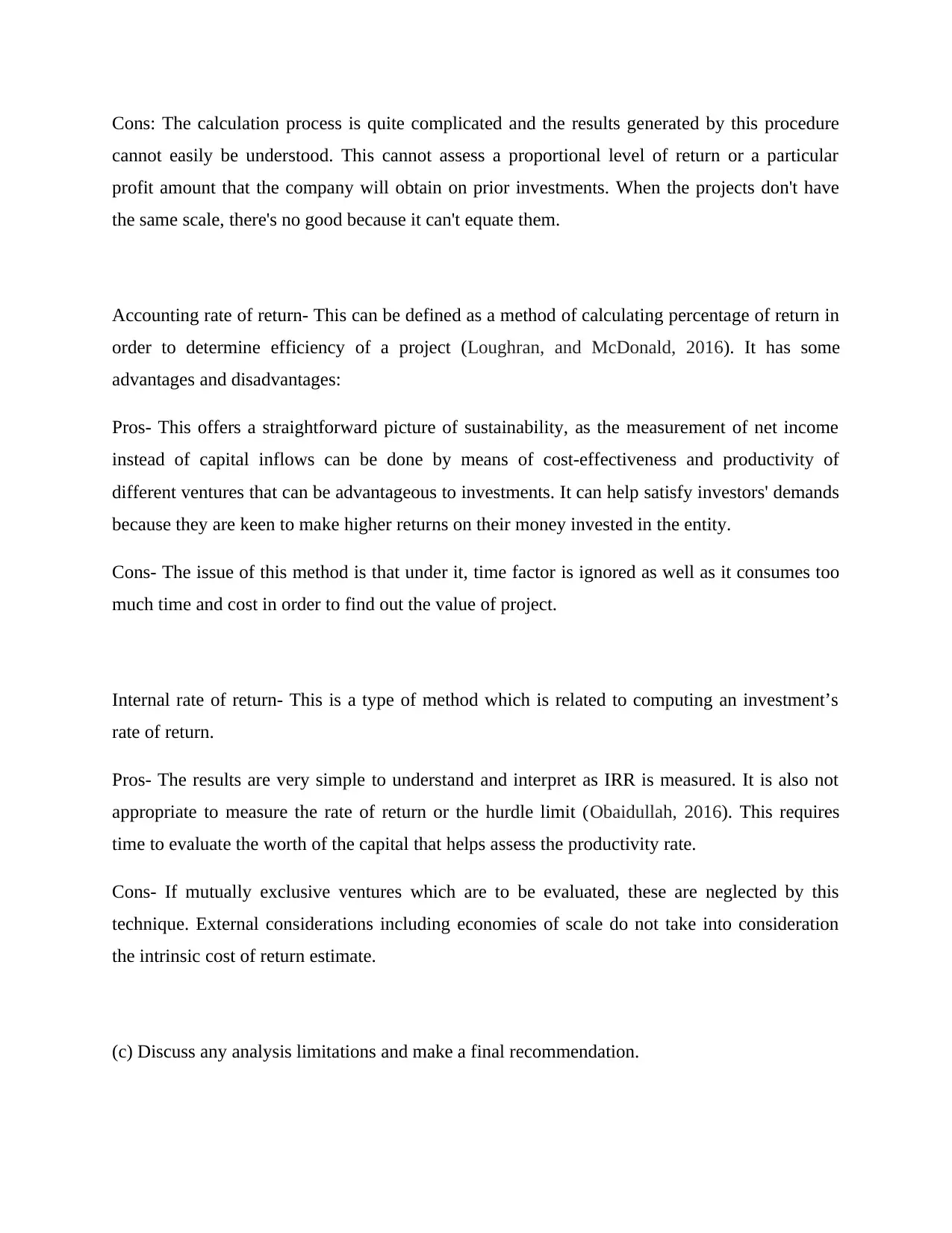
Cons: The calculation process is quite complicated and the results generated by this procedure
cannot easily be understood. This cannot assess a proportional level of return or a particular
profit amount that the company will obtain on prior investments. When the projects don't have
the same scale, there's no good because it can't equate them.
Accounting rate of return- This can be defined as a method of calculating percentage of return in
order to determine efficiency of a project (Loughran, and McDonald, 2016). It has some
advantages and disadvantages:
Pros- This offers a straightforward picture of sustainability, as the measurement of net income
instead of capital inflows can be done by means of cost-effectiveness and productivity of
different ventures that can be advantageous to investments. It can help satisfy investors' demands
because they are keen to make higher returns on their money invested in the entity.
Cons- The issue of this method is that under it, time factor is ignored as well as it consumes too
much time and cost in order to find out the value of project.
Internal rate of return- This is a type of method which is related to computing an investment’s
rate of return.
Pros- The results are very simple to understand and interpret as IRR is measured. It is also not
appropriate to measure the rate of return or the hurdle limit (Obaidullah, 2016). This requires
time to evaluate the worth of the capital that helps assess the productivity rate.
Cons- If mutually exclusive ventures which are to be evaluated, these are neglected by this
technique. External considerations including economies of scale do not take into consideration
the intrinsic cost of return estimate.
(c) Discuss any analysis limitations and make a final recommendation.
cannot easily be understood. This cannot assess a proportional level of return or a particular
profit amount that the company will obtain on prior investments. When the projects don't have
the same scale, there's no good because it can't equate them.
Accounting rate of return- This can be defined as a method of calculating percentage of return in
order to determine efficiency of a project (Loughran, and McDonald, 2016). It has some
advantages and disadvantages:
Pros- This offers a straightforward picture of sustainability, as the measurement of net income
instead of capital inflows can be done by means of cost-effectiveness and productivity of
different ventures that can be advantageous to investments. It can help satisfy investors' demands
because they are keen to make higher returns on their money invested in the entity.
Cons- The issue of this method is that under it, time factor is ignored as well as it consumes too
much time and cost in order to find out the value of project.
Internal rate of return- This is a type of method which is related to computing an investment’s
rate of return.
Pros- The results are very simple to understand and interpret as IRR is measured. It is also not
appropriate to measure the rate of return or the hurdle limit (Obaidullah, 2016). This requires
time to evaluate the worth of the capital that helps assess the productivity rate.
Cons- If mutually exclusive ventures which are to be evaluated, these are neglected by this
technique. External considerations including economies of scale do not take into consideration
the intrinsic cost of return estimate.
(c) Discuss any analysis limitations and make a final recommendation.
⊘ This is a preview!⊘
Do you want full access?
Subscribe today to unlock all pages.

Trusted by 1+ million students worldwide
1 out of 22
Related Documents
Your All-in-One AI-Powered Toolkit for Academic Success.
+13062052269
info@desklib.com
Available 24*7 on WhatsApp / Email
![[object Object]](/_next/static/media/star-bottom.7253800d.svg)
Unlock your academic potential
Copyright © 2020–2025 A2Z Services. All Rights Reserved. Developed and managed by ZUCOL.

